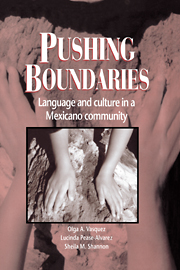Book contents
- Frontmatter
- Contents
- Foreword
- Preface
- Chapter 1 INTRODUCTION
- Chapter 2 EASTSIDE: A MEXICANO COMMUNITY
- Chapter 3 HOME AND SCHOOL CONTEXTS FOR LANGUAGE LEARNING
- Chapter 4 BILINGUAL CHILDREN CROSSING CULTURAL BORDERS
- Chapter 5 NEGOTIATING CULTURE AND LANGUAGE IN THE HOME
- Chapter 6 MOVING TOWARD A RECOGNITION PERSPECTIVE
- Chapter 7 MEETING THE CHALLENGES OF DIVERSITY
- Notes
- References
- Index
Chapter 4 - BILINGUAL CHILDREN CROSSING CULTURAL BORDERS
Published online by Cambridge University Press: 26 March 2010
- Frontmatter
- Contents
- Foreword
- Preface
- Chapter 1 INTRODUCTION
- Chapter 2 EASTSIDE: A MEXICANO COMMUNITY
- Chapter 3 HOME AND SCHOOL CONTEXTS FOR LANGUAGE LEARNING
- Chapter 4 BILINGUAL CHILDREN CROSSING CULTURAL BORDERS
- Chapter 5 NEGOTIATING CULTURE AND LANGUAGE IN THE HOME
- Chapter 6 MOVING TOWARD A RECOGNITION PERSPECTIVE
- Chapter 7 MEETING THE CHALLENGES OF DIVERSITY
- Notes
- References
- Index
Summary
Becoming bilingual and bicultural is a natural part of growing up in the east side. Most Mexicano children experience their preschool years immersed in a largely Mexicano cultural environment where Spanish predominates. Once in school, they start learning English and gain enough knowledge of Anglo culture so that they are well on the road to becoming bilingual and bicultural. This allows them to benefit from further exposure to English in everyday life and to the cultures that exist outside of their homes and schools. As they are exposed to the media, mainstream institutions, and individuals from two or more cultures and communities, Eastside children become increasingly bilingual and multicultural. Their eclectic knowledge and skills, in turn, contribute to the children's ability to act as valuable resources for their families by helping them to negotiate an unfamiliar language and culture. Paying the rent, enrolling children in school, receiving health care, and applying for a job are occasions when Spanish-speaking adults routinely call upon their bilingual children to help them communicate more effectively with English speakers and to better understand institutional culture.
Ironically, outsiders to the community frequently describe the east side as a place where English is seldom used and where residents have no interest in learning it. Terms they use to describe the east side, including “Little Mexico”and “El Barrio,” are often intended to convey the sense of a community that is immune, if not resistant, to the influences of mainstream society.
- Type
- Chapter
- Information
- Pushing BoundariesLanguage and Culture in a Mexicano Community, pp. 80 - 109Publisher: Cambridge University PressPrint publication year: 1994



